
The birds-of-paradise are members of the family Paradisaeidae of the order Passeriformes. The majority of species are found in eastern Indonesia, Papua New Guinea and eastern Australia. The family has 45 species in 17 genera. The members of this family are perhaps best known for the plumage of the males of the species, the majority of which are sexually dimorphic. The males of these species tend to have very long, elaborate feathers extending from the beak, wings, tail or head. For the most part they are confined to dense rainforest habitat. The diet of all species is dominated by fruit and to a lesser extent arthropods. The birds-of-paradise have a variety of breeding systems, ranging from monogamy to lek-type polygamy.

The blue bird-of-paradise is a beautiful, relatively large species of bird-of-paradise. It is the only species in the genus Paradisornis, but was previously included in the genus Paradisaea.

The genus Paradisaea consists of six species of birds-of-paradise. The genus is found on the island of New Guinea as well as the nearby islands groups of the Aru Islands, D'Entrecasteaux Islands and Raja Ampat Islands. The species inhabit a range of forest types from sea level to mid-montane forests. Several species have highly restricted distributions, and all species have disjunct distributions. A 2009 study examining the mitochondrial DNA of the family found that the Paradisaea birds-of-paradise were in a clade with the genus Cicinnurus. It showed that the blue bird-of-paradise was a sister taxon to all the other species in this genus.

The red bird-of-paradise, also called the cendrawasih merah, is a bird-of-paradise in the genus Paradisaea, family Paradisaeidae.

The Halmahera paradise-crow also known as the silky crow, is a medium-sized crow-like bird-of-paradise.

The king bird-of-paradise is a passerine bird of the Paradisaeidae (bird-of-paradise) family. It is considered by the IOC checklist to be the only member of the genus Cicinnurus, although the genus Diphyllodes is closely related and is subsumed under Cicinnurus by many other authorities.
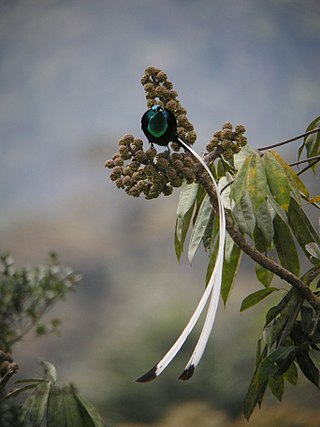
Astrapia is a genus of birds-of-paradise. The genus contains five species, all endemic to New Guinea. The males have highly iridescent plumage and remarkably long tails. Females are duller and have shorter tails.

The long-tailed paradigalla is a large, approximately 37 cm long, black bird-of-paradise with long and pointed tail. One of the most plain members in the family Paradisaeidae, its only adornment is the colorful facial wattles of yellow, red and sky-blue near base of the bill. Both sexes are similar in appearance, however the female is slightly duller and smaller.

Lophorina is a genus of birds in the birds-of-paradise family Paradisaeidae that are endemic to New Guinea, formerly containing a single species, but as of 2017, containing three species.

The magnificent bird-of-paradise is a species of bird-of-paradise. The magnificent bird-of-paradise is evaluated as Least Concern on the IUCN Red List of Threatened Species. They are listed on Appendix II of CITES.
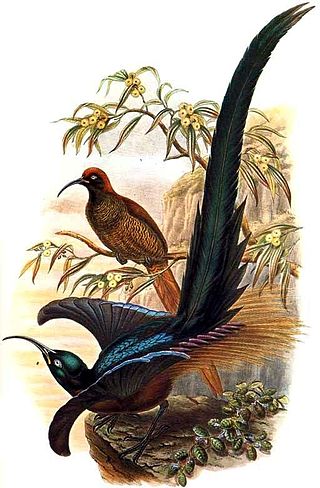
The brown sicklebill is a species of bird-of-paradise that is found in the mountain forests of New Guinea.

The pale-billed sicklebill is a species of sicklebill that belongs to the family Paradisaeidae, which contains the birds-of-paradise.
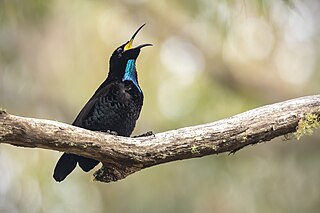
The paradise riflebird is a passerine bird of the family Paradisaeidae. It is one of four riflebird species in the genus Ptiloris. It is found in subtropical, temperate rainforests in eastern Australia. The species is sexually dimorphic; the male is black with iridescent blue-green patches, while the female is gray-brown and white.

Lawes's parotia, is a medium-sized passerine of the bird-of-paradise family, Paradisaeidae. It is distributed and endemic to mountain forests of southeast and eastern Papua New Guinea. Occasionally, the eastern parotia is considered a subspecies of P. lawesii. The species is similar to the western parotia.
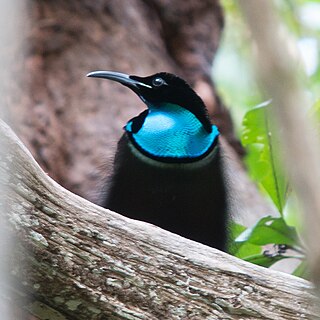
The magnificent riflebird is a species of passerine bird in the birds-of-paradise family Paradisaeidae.

Manucodes are birds-of-paradise in the genus Manucodia, that are medium-sized with black-glossed purple and green plumages.
Barnes's astrapia, also known as Barnes's long-tailed bird-of-paradise or Barnes's long-tail, is a bird in the family Paradisaeidae and the genus Astrapia that is a likely hybrid between Stephanie's astrapia and the ribbon-tailed astrapia.

The King of Holland's bird of paradise, also known as King William III's bird of paradise or the exquisite little king, is a bird in the family Paradisaeidae that is a hybrid between a magnificent bird of paradise and king bird of paradise.
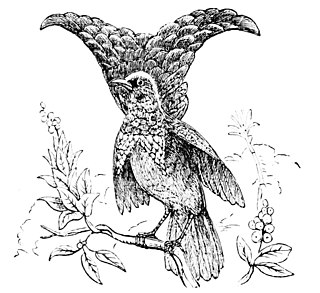
The crescent-caped lophorina or Vogelkop superb bird-of-paradise, sometimes noted as the curl-caped bird-of-paradise, is a species of the Paradisaeidae (bird-of-paradise) family. It is endemic to the Bird's Head Peninsula in New Guinea. First described in 1930 by Ernst Mayr, it had been treated as a subspecies of the superb bird-of-paradise but was elevated to the status of a full species in 2017, and reinforced in 2018 based on its striking black plumage and behavioral differences, especially visible in the courting male.
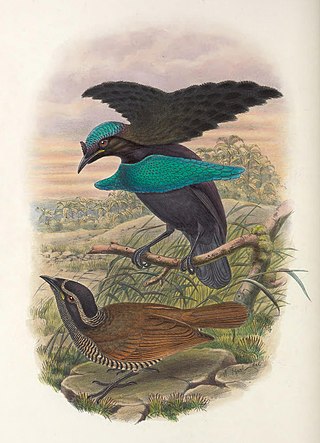
The lesser lophorina, also known as lesser superb bird-of-paradise or rasping bird-of-paradise, is a species of passerine bird in the bird-of-paradise family Paradisaeidae.


















